AMD vs Nvidia: Who Makes the Best GPUs?
The AMD vs Nvidia GPU battle rages on. Here's how the two stack up.

AMD vs Nvidia. If you're building a gaming PC, you'll inevitably be faced with choosing between the two GPU heavyweights. Both companies make GPUs that power the best graphics cards, fighting for supremacy in our GPU benchmarks hierarchy. AMD vs Nvidia isn't the only decision you’ll need to make when building a PC, of course. You'll also need to choose between AMD vs Intel CPUs. Our focus here will be on graphics, however, and we'll be looking at performance, features, drivers and software, power and efficiency, pricing and more.
The AMD vs Nvidia flame wars have been cooking since the late 90s, with Nvidia currently leading in the GPU arena by many metrics. Its graphics cards account for the majority of GPUs on the Steam Hardware Survey, for example, and in terms of pure finances, Nvidia is worth roughly three times as much as AMD (with a large chunk of AMD's resources devoted to CPUs).
But we're not interested in the distant past or finances. We want to find a winner in the current battle of AMD vs Nvidia GPUs. That primarily means looking at AMD Big Navi and Nvidia Ampere graphics cards — and maybe one of these days, we'll even need to add Intel Arc into the mix.
It's important to keep the big picture in view throughout this analysis. We're not just focusing on the fastest GPU, or the most power-efficient GPU, or the best bang-for-the buck GPU. We'll consider all of the factors in each category, from budget to mid-range to high-end and extreme GPUs, along with the tech behind the GPUs. We will declare a winner today, but of course this isn't the end of the war. It's more like owning the heavyweight GPU title: A victory today doesn't mean your opponent won't come back leaner and meaner next year.
With that preamble out of the way, let's pull out the boxing gloves and go the rounds with AMD vs Nvidia.
AMD vs Nvidia: Gaming Performance
For decades, faster GPUs have enabled game developers to create increasingly detailed and complex worlds. While you can find everything from budget GPUs to high-end offerings from both AMD and Nvidia, when it comes to outright performance, Nvidia has a slight overall lead thanks to the chunky GeForce RTX 3090 Ti.
Beyond the pole position, however, it's a closer match. If you look at our GPU benchmarks hierarchy, you'll see that AMD's RX 6950 XT owns the top spot at 1080p and 1440p, and Nvidia only wins at 4K or in ray tracing games. Of the top ten fastest GPUs, four are AMD and six are Nvidia, but part of that is thanks to quantity rather than truly different GPUs — the RTX 3080 12GB takes a bit of RTX 3080 Ti and a bit of RTX 3080 and mixes them together into a card that ended up matching the 3080 Ti at a lower price point.
Of course, the main benchmarks only look at games running APIs and settings that work on all GPUs, which means we haven't included ray tracing or DLSS in the results. We also haven't included any FSR results, and CPU bottlenecks certainly play a role at lower resolutions. Here's the updated 2022 performance rankings, showing the overall performance from eight games and four settings/resolutions combinations four our standard test suite, and four more charts for our ray tracing suite that uses six complex DXR (DirectX Raytracing) games.

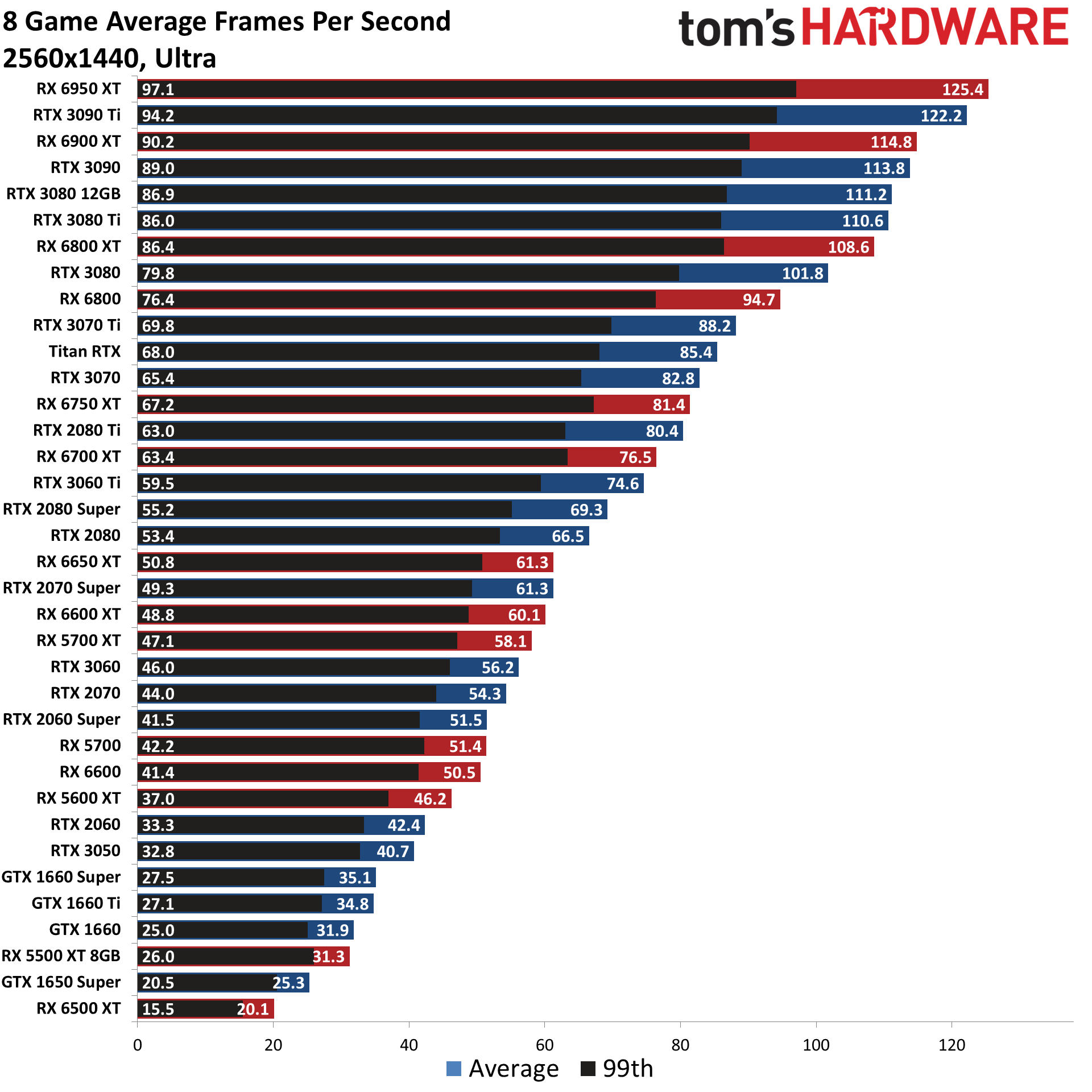
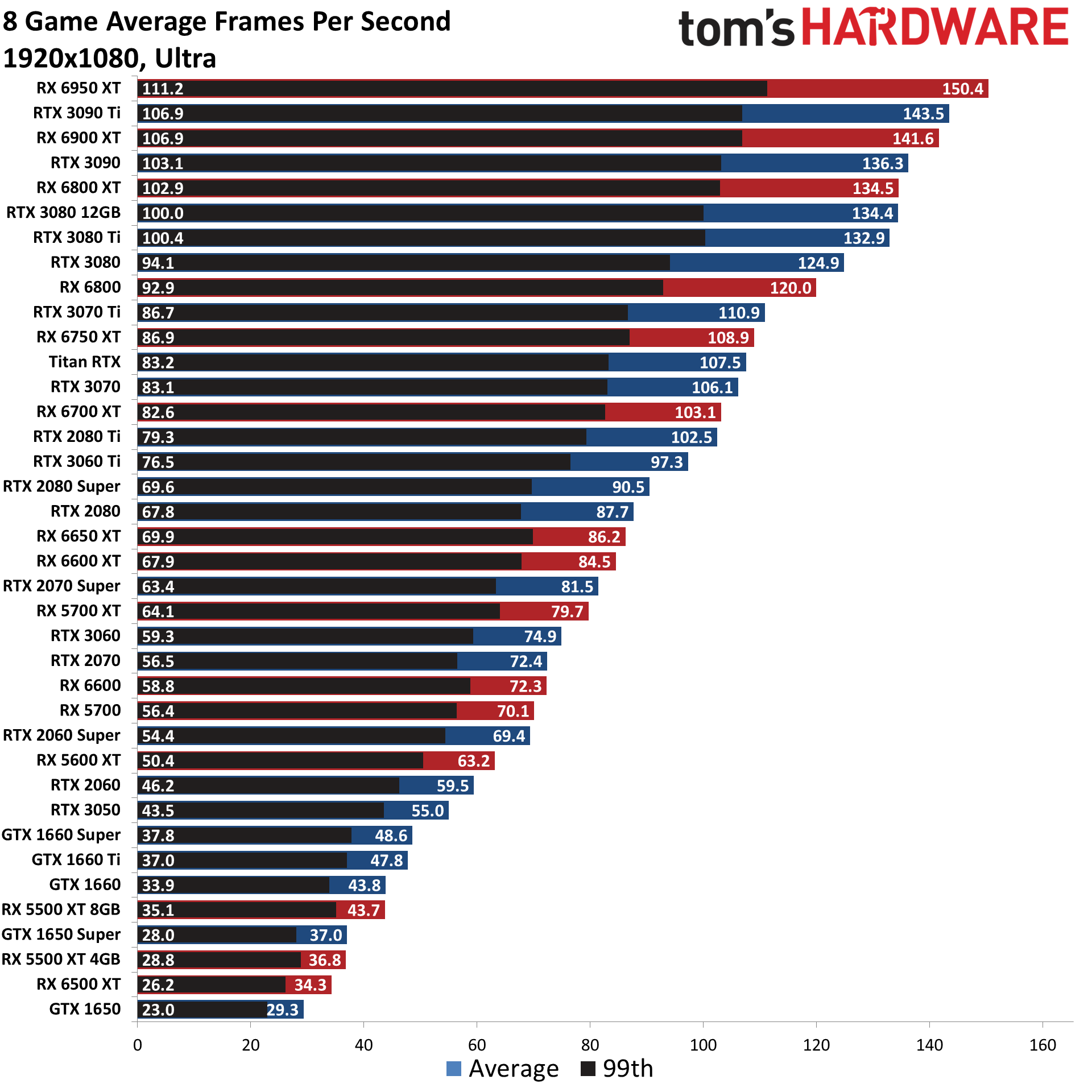

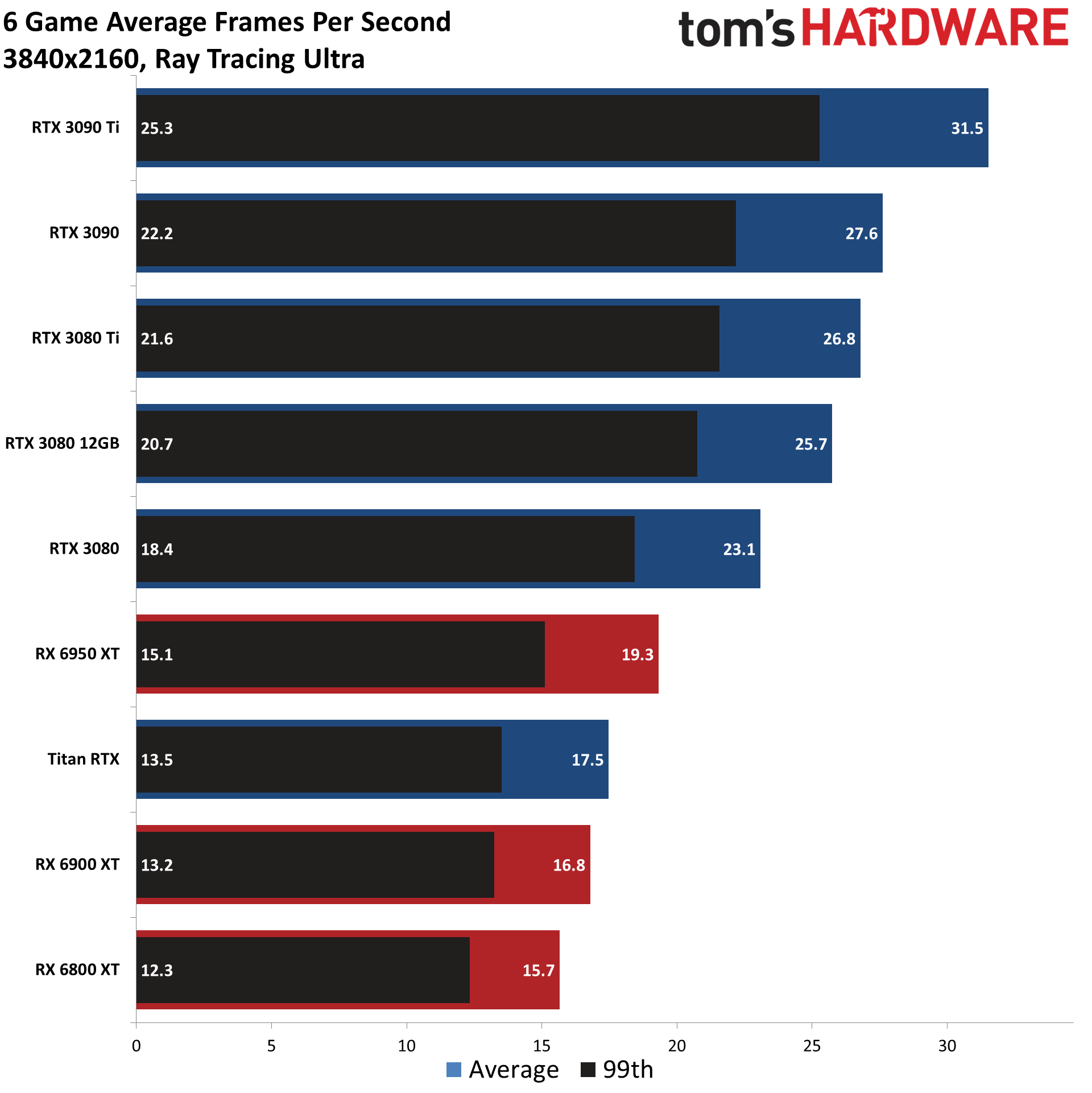


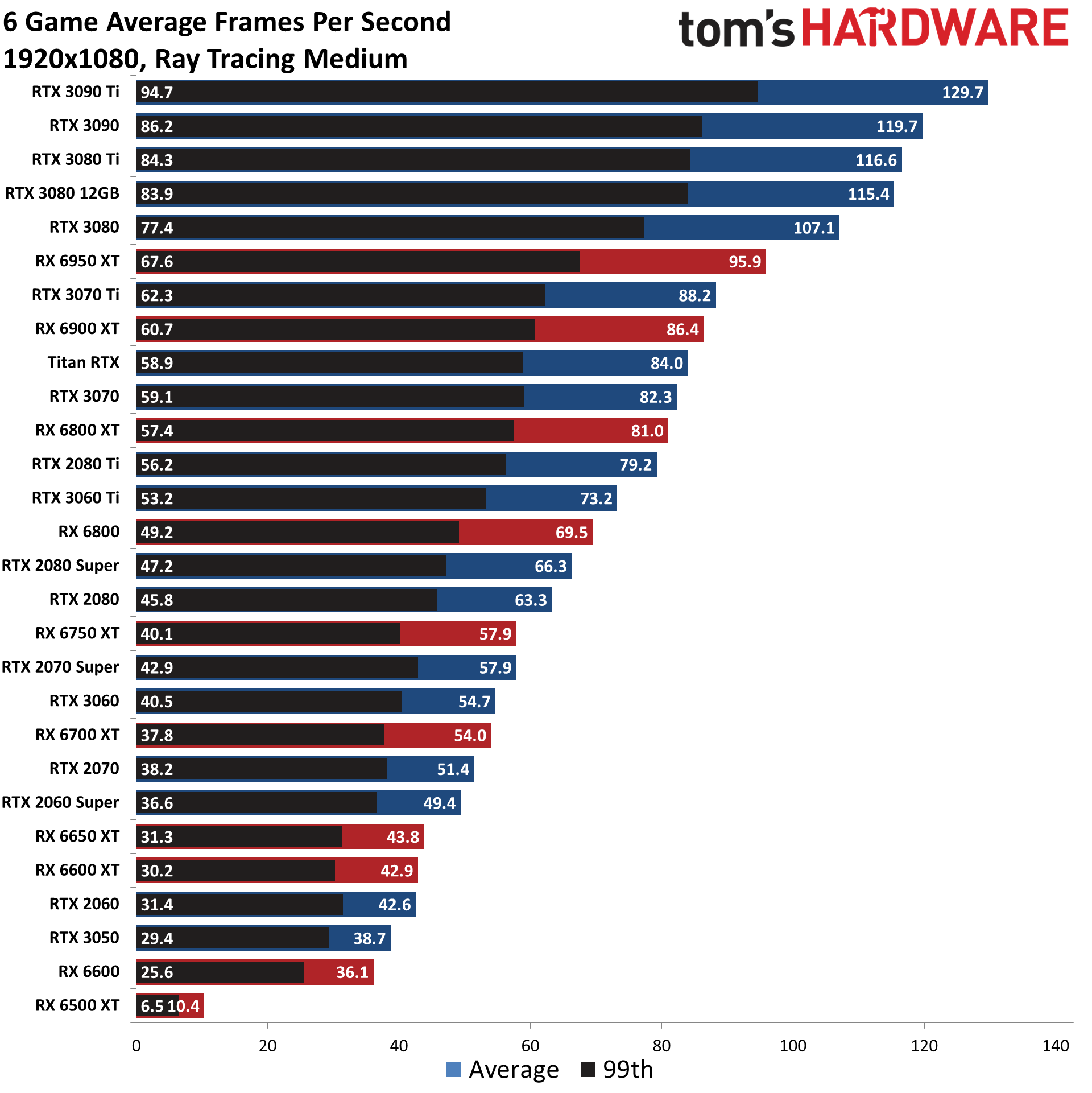
Nvidia's RTX 3090 Ti isn't remotely affordable, while the GeForce RTX 3080 and Radeon RX 6800 XT represent a better view of performance. Those two trade blows in traditional rasterization games, with AMD taking a slight lead, while Nvidia easily jumps ahead — often by a large margin — as soon as ray tracing and/or DLSS get turned on. We give Nvidia a slight lead at the top of the performance ladder, but that's not the only category to consider.
Looking at the mainstream market ($400, give or take), things get a bit messy. AMD's Radeon RX 6700 XT takes on the GeForce RTX 3060 Ti, with slightly better performance — provided once again that we ignore RT and DLSS. In our review, we called it a net tie. However, while AMD's card theoretically costs 20% more than Nvidia's offering, in practice pricing actually favors AMD right now ($480 vs. $500 at the time of writing).
Older model GPUs are mostly outclassed by the new arrivals, so the best pairing would be pitting the RTX 3050 against the RX 6600, both of which can be had for around $300 (never mind MSRPs). AMD's GPU crushes the 3050 in standard gaming performance by 25–35%, and while ray tracing does favor the Nvidia GPUs by 7–15%, that's far less critical for this category.
What about budget offerings, like stuff for under $200? Sadly, we have to wonder where all the good budget GPUs have gone. The RX 6500 XT and RX 6400 sell for under $200, but performance is generally worse than the old RX 5500 XT 8GB and GTX 1660, instead going up against the GTX 1650 and 1650 Super. AMD's cards are easy enough to find brand new, while Nvidia's GTX 16-series parts are now coming up on three years old and supply and availability can be a bit spotty. Still, Newegg has GTX 1650 Super for $200, effectively making the budget sector a tie.
Winner: Tie This is simply too close to call, as there are so many ways to split things. Nvidia wins for 4K and ray tracing performance, AMD wins for standard 1080p and 1440p gaming, and also in performance at similar high-end and mid-range price points. DLSS also counts in Nvidia's favor, however, and while FSR 2.0 might be relatively competitive, it works on any GPU.
AMD vs Nvidia: Power Consumption and Efficiency
Prior to AMD's Navi, GPU power efficiency was decidedly in favor of Nvidia. But Navi changed all that, and Big Navi has further improved AMD's efficiency. Using chips built with TSMC's 7nm FinFET process and a new architecture that delivered 50% better performance per watt, Navi started to close the gap. Except, it was so far behind that even a 50% improvement didn't fully address the efficiency deficiency.
But Nvidia's Ampere architecture pushed higher clocks at the cost of efficiency, while AMD's Big Navi gets a healthy boost in efficiency from the Infinity Cache. The net result is that Ampere and Big Navi are pretty close to tied.
Using Powenetics hardware to capture the real graphics card power use of GPUs, we've tested all of the current and recent graphics cards from both companies. We've also tested third party cards from both sides, but we'll confine the charts to the reference designs as much as possible.
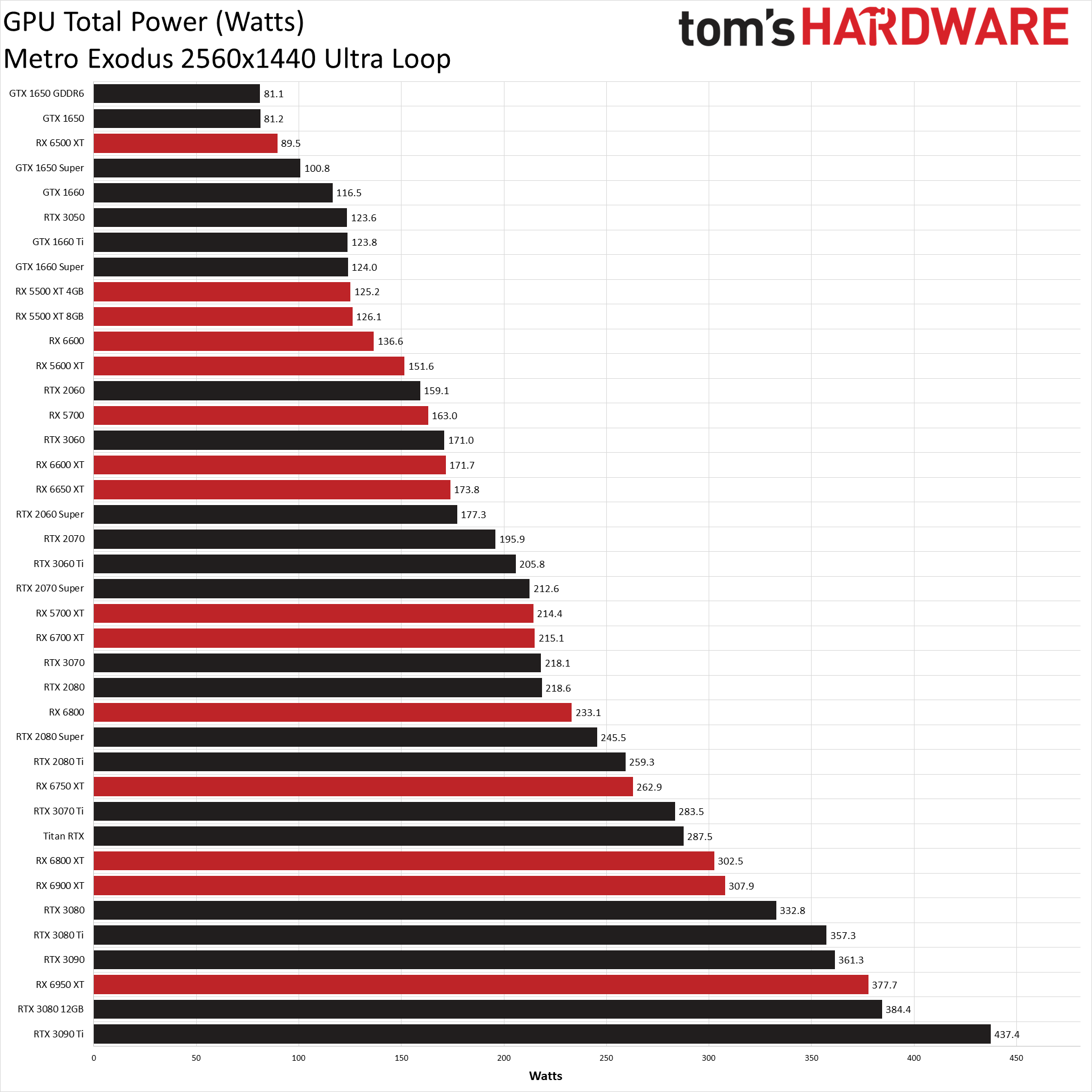
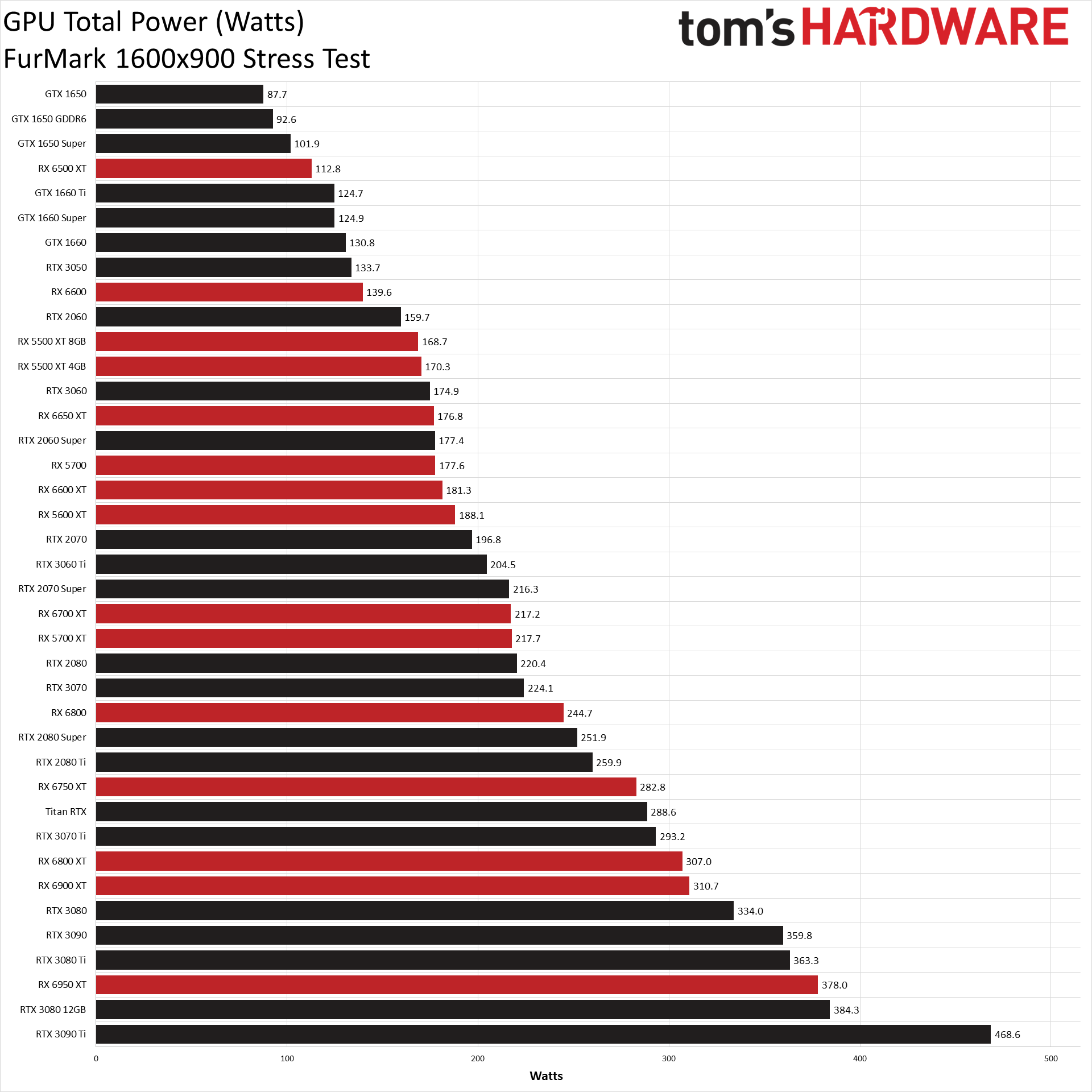
While power use favored Nvidia's older GPUs, sometimes by a wide margin, the differences on the latest generation hardware go the other way. RTX 3090 Ti uses the most power, followed by the RX 6950 XT, RTX 3080 12GB (custom card), and then we get the RTX 3090, 3080 Ti, and 3080. AMD's RX 6900 XT and 6800 XT come next, before we start getting to previous generation GPUs.
It's more difficult to declare a winner outside of the extreme performance range. AMD's RX 6700 XT uses a bit more power than the RTX 3060 Ti and a bit less than the RTX 3070, but they're all in a 10W range. Drop down to the RTX 3060 and RTX 3050 against the RX 6600 XT and RX 6600, and power use tracks pretty closely with performance.
Among budget GPUs, the RX 6500 XT uses more power than the GTX 1650, but the RX 6400 is the only truly modern GPU that doesn't need at least a PCIe 6-pin power connector.
Get Tom's Hardware's best news and in-depth reviews, straight to your inbox.
Winner: AMD Focusing just on the current generation AMD Big Navi and Nvidia Ampere GPUs, power and efficiency are relatively close. AMD takes a slight lead at the top, the middle's a tie, and AMD wins in the budget sector as well, giving it the overall nod. TSMC's N7 process also factors in, helping out AMD, while Nvidia's use of Samsung 8N likely accounts for reduced overall efficiency.
AMD vs Nvidia: Featured Technology
Most of the features supported by AMD and Nvidia seem similar, though the implementations do vary. Both support ray tracing now, which allows for some nice effects, but it's not required to get a good gaming experience. Nvidia's DLSS is a bigger factor, as FidelityFX Super Resolution (FSR) doesn't look as good in the FSR 1.0 implementation, while FSR 2.0 isn't widely adopted yet — and in either case, FSR works on AMD and Nvidia GPUs, and even Intel integrated graphics. That's actually a point to AMD for not locking people into its hardware, but practically speaking there are a lot of games with DLSS support and it can be an nice extra.
There are other aspects as well. G-Sync takes on FreeSync, Radeon Anti-Lag goes up against Nvidia's ultra-low latency mode plus Reflex, Radeon Super Resolution (RSR) works in a similar way to Nvidia Image Scaling (NIS), and there other areas where features effectively match up as well.
Supporting the same APIs and similar hardware features doesn't make things equivalent, however. Ampere and RDNA2 also support mesh shaders and variable rate shading (VRS), as well as some other features that are all part of the DirectX 12 Ultimate spec. But Nvidia's performance in ray tracing tends to be quite a bit higher than AMD, even without DLSS.
While FreeSync and G-Sync might seem equivalent on the surface, the best G-Sync displays are almost invariably higher quality and better latency than FreeSync displays. The same goes for AMD's anti-lag and Nvidia's ultra-low latency and Reflex: Similar in theory, but in practice Reflex implementations come out on top.
Video encoding and decoding are another important aspect, and here Nvidia definitely comes out ahead. The Turing and Ampere codecs support higher-quality encodes and lower GPU utilization, both good things. There's no need for CPU-based video encoding with Nvidia's latest GPUs. AMD's budget Navi 24 chips lack some key video encoding features as well.
There is one area where AMD has a clear advantage, though it's also perhaps to AMD's detriment. TSMC's N7 process that AMD uses for RDNA2 (and RDNA and Zen 3 and the PS5/XSX) chips clearly delivers better performance and power characteristics than Samsung's custom 8N (really just an improved version of Samsung's 10LPP process). The catch being that lots of other companies also want to partake of TSMC's goodness — AMD, Apple, Nvidia GA100, Qualcomm, and even Intel all use TSMC, along with various other smaller players. This becomes a problem when TSMC doesn't have enough capacity to meet the demands of all of those companies.
Winner: Nvidia While AMD and Nvidia have superficial parity on most features, Nvidia's implementations are generally superior — and cost more. G-Sync, Reflex, DLSS, and NVENC all end up being at least slightly better than AMD's alternatives.
AMD vs Nvidia: Drivers and Software
Trying to determine a clear winner in the drivers and software category is difficult. Quite a few people previously encountered black screen issues with AMD drivers on RX 5000 Navi series GPUs, while others didn't have any difficulties. Newer drivers have fixed these problems, as far as we can tell. Nvidia drivers aren't foolproof either, and depending on the game and hardware, issues crop up for both companies. But is one company doing better with drivers?
AMD makes a lot of noise about its yearly driver overhaul. The Radeon Adrenalin 2020 drivers consolidated everything under one large umbrella, aiming to simplify things, though it can be confusing at first if you're used to the older drivers. AMD tends to skip WHQL (Windows Hardware Quality Labs) testing, which means fewer hoops to jump through and potentially more bugs slip through, but Microsoft's insurance of a minimum level of functionality doesn't really mean much for gaming purposes.
You can generally count on at least one new AMD driver per month, often more if there are major game launches. Nvidia's driver schedule follows a similar cadence. You'll get new drivers for major game launches or new graphics card hardware. Nvidia's releases (outside of rare hotfixes) are all WHQL certified, and Nvidia also has a separate Studio Driver branch for content creators.
One of the big differences between AMD and Nvidia drivers is that Nvidia has two separate user interfaces. The Nvidia Control Panel handles things like resolutions and certain graphics settings, while GeForce Experience tackles game optimizations, driver updates, and extra features including ShadowPlay, Ansel, NIS, and more. Annoyingly, you have to log in and solve a captcha prompt to use GeForce Experience, which is something I've done more times than I’d ever want to count. Just say no to data mining plus drivers.
Winner: Tie We prefer AMD's unified driver approach, as it's one less interface to navigate, but there's just so much stuff in the current releases. Nvidia's Q&A is arguably better, though plenty of bugs and issues end up slipping through on both sides. Quantifying drivers ends up being an incredibly subjective affair, however, so we're calling this one a draw as well.
AMD vs Nvidia: Pricing and Availability
Who offers the better value in the battle of AMD vs Nvidia? The past two years have been a bit of a joke (not a funny one, either), but things are now greatly improved. You can find all the latest graphics cards in stock at retail now, with many models selling at or below MSRP. But of the "many" selling at or below MSRP, far more are using AMD GPUs than Nvidia GPUs, with only the extremely priced RTX 3080 Ti and above selling below MSRP from Team Green.
Our GPU pricing index looks at eBay pricing as an alternative, but it's no longer required. In general, the simple fact is that the best values are currently from AMD, with the RX 6600, RX 6600 XT, RX 6650 XT, RX 6700 XT, and RX 6750 XT all ranking near the top of the FPS per dollar charts. Nvidia's RTX 3060, 3050, and 3060 Ti aren't horribly option, but you're paying about 15–25% more in terms of FPS per dollar (and getting DLSS for that money).
At the top of the pricing spectrum, the RTX 3090 Ti is the unquestioned worst value, priced at over $1,800 and only delivering slightly more performance than the RTX 3080 Ti. AMD's RX 6950 XT doesn't cost nearly as much and competes well against the 3080 Ti, but as we go down the pricing scale things begin to favor AMD a lot more.
Right now, the RX 6600 takes top honors with around 0.23 fps per dollar spent. Nvidia's highest ranking GPUs come from its previous generation Turing RTX 20-series, where the RTX 2060 scores 0.196 FPS/$, but the highest RTX 30-series part only rates 0.176 FPS/$. AMD's RX 6500 XT is right in the mix for a budget card, also at 0.176 FPS/$.
Winner: AMD With the supply of graphics cards greatly improving, at least partly thanks to cryptocurrency mining profitability being in the dumps, the value proposition finally becomes meaningful again for the first time in about two years. GPU prices continue to drop, but for now AMD's RX 6000-series cards represent a better value than Nvidia's RTX 30-series parts.
| Round | Nvidia GeForce | AMD Radeon |
|---|---|---|
| Gaming Performance | ✗ | ✗ |
| Power Consumption | Row 1 - Cell 1 | ✗ |
| Featured Technology | ✗ | Row 2 - Cell 2 |
| Drivers and Software | ✗ | ✗ |
| Price and Value | Row 4 - Cell 1 | ✗ |
| Total | 3 | 4 |
AMD vs Nvidia: Bottom Line
With an overall score of four to three, AMD squeaks out a victory and lays claim to the king of the GPU world crown. Cue the band and light the fireworks. That doesn't mean AMD GPUs are a better choice in every case, and there's a lot of fuzzy math and subjectivity involved, but you should be well served by Team Red's RDNA 2 GPUs — and just about equally well served by Team Green.
Overall, which GPU you prefer will likely come down to personal preference rather than hard numbers. AMD clearly wins most match ups (comparing similar priced cards) in standard benchmarks, but it falls behind in ray tracing games and DLSS still factors in. We could certainly see people being willing to pay 10–15% more money to get an Nvidia card, even if it may not technically be the "best" choice.
At this point, we're now looking forward to the future RDNA 3 and Ada Lovelace graphics cards, both of which we expect to see before the end of the year. There are still too many unknowns to even venture a guess at who will be on top by the end of the year, but hopefully the end of 2022 ends up being far better for gamers looking to upgrade their GPU than 2020 and 2021 were.

Jarred Walton is a senior editor at Tom's Hardware focusing on everything GPU. He has been working as a tech journalist since 2004, writing for AnandTech, Maximum PC, and PC Gamer. From the first S3 Virge '3D decelerators' to today's GPUs, Jarred keeps up with all the latest graphics trends and is the one to ask about game performance.
-
mitch074 For me, it's AMD all the way: they are the only ones with a serious product with open source support.Reply -
DZIrl Replymitch074 said:For me, it's AMD all the way: they are the only ones with a serious product with open source support.
Well, I wrote about my experience with AMD support before and now how it looks with NVIDIA: I had an issue and submitted a ticket. In a day or two quite large reply with steps what to try. So, completely opposite to AMD!
Also my AMD drivers experience (motherboard) is everything but satisfactory! There were several articles about it. On NVIDIA side "Geforce Experience" app allows me to switch between game and studio driver at run-time without rebooting, check for update and install them, etc.
On HW side as we see NVIDIA is faster but also, like Intel, more expensive. AMD still does not have Ray Tracing.
All this is very good cause like Intel NVIDIA will be forced to reduce price and they already did. A bit but did. -
bit_user Reply
Yes, between those two, AMD is currently the only good open source citizen.mitch074 said:For me, it's AMD all the way: they are the only ones with a serious product with open source support.
However, Intel also has open source drivers and makes many open source contributions. Furthermore, they're pretty much the last one still supporting OpenCL (which, before someone mentions it, is actually the foundation of their oneAPI stack). -
yeeeeman Drivers and Software is a tie???!???Reply
Were you a bit drunk when you wrote this article?
Reddit, forums, youtube, the internet is basically full of people showing bluescreens, blackscreens, flickering and various other problems with the RX5700 series and you say this is a tie?
It is like you are comparing two cars, one with a flat tire and one not and say they are both ok....
Amd is pure crap on drivers. Software is more feature packed, I give you that, but everything is useless if drivers are so utterly crap and who knows, even the hardware has some unfixable bugs that are just patched in firmware/software.
So currently there is basically no discussion.
Cheap people buy AMD but then start to cry on reddit.
Smart people pay a bit more for an nvidia card and enjoy a quality experience.
AMD cards are bought by people that want to cheap out and enjoy saving 20 bucks but then complain about the bad experience...DZIrl said:On HW side as we see NVIDIA is faster but also, like Intel, more expensive. AMD still does not have Ray Tracing.
All this is very good cause like Intel NVIDIA will be forced to reduce price and they already did. A bit but did. -
spongiemaster Reply
AMD has so much open source software support because they can't afford to fully develop the software to a polished product themselves so they dump it into open source and hope someone will do it for them. The company's history going back to their ATi days is littered with failed software features they promised on launch day that never were fully developed. AMD should open source their Windows drivers too. There's no way the community at large would produce drivers as consistently terrible as AMD has and take so long to fix known bugs.mitch074 said:For me, it's AMD all the way: they are the only ones with a serious product with open source support. -
mrv_co I've been very happy with my PowerColor 5700 XT. I'm content to wait another generation for hardware (not to mention more games) at this price point that can actually run ray tracing at respectable frame rates without so much of a compromise on resolution and quality.Reply -
mitch074 Reply
Oooh, butthurt much. I've been gaming on Linux since 2006 with both Nvidia and AMD cards, and right now, the biggest hurdle I had right after rebuilding my rig was, format and install the new system boot, install the very latest developer build for the Mesa drivers (just because, and a 60 Mb download that contains the very latest fixes for the very latest games is good), install Steam (3 clicks, login), install Doom Eternal and play it, I do mean the BIGGEST problem I had with that process was setting up a Bethesda account...spongiemaster said:AMD has so much open source software support because they can't afford to fully develop the software to a polished product themselves so they dump it into open source and hope someone will do it for them. The company's history going back to their ATi days is littered with failed software features they promised on launch day that never were fully developed. AMD should open source their Windows drivers too. There's no way the community at large would produce drivers as consistently terrible as AMD has and take so long to fix known bugs.
Said game just ran beautifully @1440p Ultra Nightmare on a reference RX480 8Gb.
Doing the same for Nvidia required me to enable proprietary drivers, download a compiler and a linker along with the kernel's symbols, determine which driver version was best for my card (because it's not the very latest model, see), wait for the 500 Mb download to finish, wait for the compilation to end, reboot, redefine my monitor's setup in Nvidia's proprietary tool and then hope it would work (which it doesn't always). -
nofanneeded Well had AMD bought Nvidia instead of ATI , we would have said AMD is the best lol. it is ATI team guys, bought and inseted in AMD.Reply -
spongiemaster Reply
Congrats on your linux experience, I guess. None of this has anything to do with anything in my post.mitch074 said:Oooh, butthurt much. I've been gaming on Linux since 2006 with both Nvidia and AMD cards, and right now, the biggest hurdle I had right after rebuilding my rig was, format and install the new system boot, install the very latest developer build for the Mesa drivers (just because, and a 60 Mb download that contains the very latest fixes for the very latest games is good), install Steam (3 clicks, login), install Doom Eternal and play it, I do mean the BIGGEST problem I had with that process was setting up a Bethesda account...
Said game just ran beautifully @1440p Ultra Nightmare on a reference RX480 8Gb.
Doing the same for Nvidia required me to enable proprietary drivers, download a compiler and a linker along with the kernel's symbols, determine which driver version was best for my card (because it's not the very latest model, see), wait for the 500 Mb download to finish, wait for the compilation to end, reboot, redefine my monitor's setup in Nvidia's proprietary tool and then hope it would work (which it doesn't always). -
mitch074 Reply
No, it's just that it goes against your world view that AMD needs the community to run their graphics cards on Linux. It's not, it only allows them to have the best experience on Linux. On Windows Nvidia is king, on Linux not so much.spongiemaster said:Congrats on your linux experience, I guess. None of this has anything to do with anything in my post.


